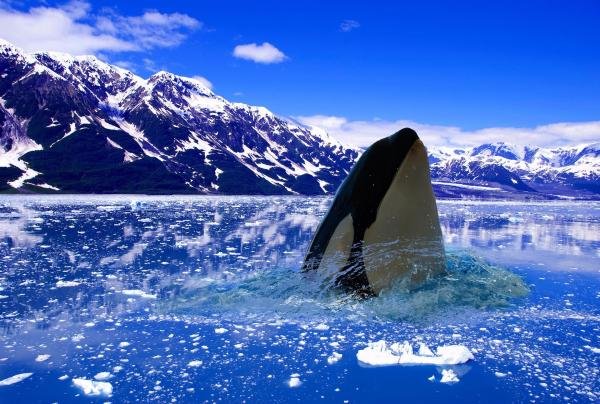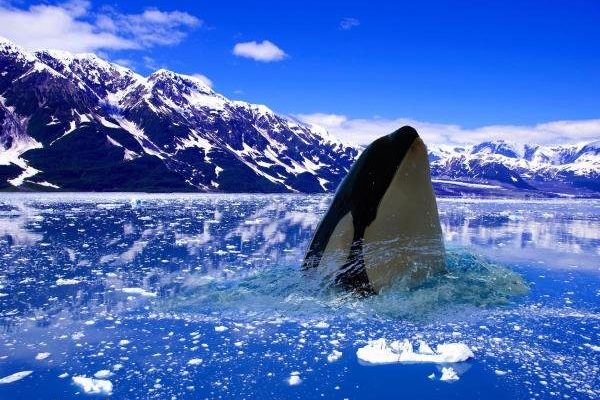
Here’s the thing: orcas are incredibly adaptable. They’ve learned to thrive in diverse habitats, from bustling coastlines to the serene depths of remote fjords. This flexibility is part of what makes them so fascinating. Let’s take a closer look at where orcas can be found, exploring their oceanic territories as well as their surprising ventures into rivers and some unique habitats.
Understanding Orca Habitats
Orca habitats are as varied as their personalities. These intelligent creatures prefer to inhabit regions with abundant food sources, and they can be found in almost every ocean around the globe. But their exact whereabouts can depend on several factors like prey availability, water temperature, and even social structure.
Key habitats include:
- Open Oceans: Orcas roam vast stretches of ocean, chasing schools of fish and hunting marine mammals.
- Coastal Areas: They often stay near shorelines where prey is plentiful, making coastal waters rich hunting grounds.
- Ice-Covered Regions: Some populations, like those in the Arctic, have adapted to hunt seals beneath the ice.
- Rivers: In some cases, orcas will venture into rivers for specific prey, like salmon.
In essence, orcas are like expert navigators, moving through diverse environments depending on what they need at the time. This adaptability is one of the reasons they can thrive in so many different habitats.
The Oceans: Orcas’ Primary Habitat
Most orcas call the ocean their home. These marine mammals are found in all major oceans, though they seem to prefer colder waters. You’re likely to spot them in places like the North Pacific and Antarctic waters, where they can hunt for their favorite snacks—like seals and sea lions.
Distinct Ocean Regions:
- North Pacific: This region is a hotspot for orcas, especially around the coastal waters of Alaska, British Columbia, and California.
- Atlantic Ocean: Orcas can also be found off the coast of eastern Canada and in the waters of Norway and Iceland.
- Southern Ocean: These whales gather in Antarctica, where the cold waters are rich in krill and fish.
Orcas can sometimes be spotted in deeper waters, but they usually stay within about 600 feet of the surface, where their prey is abundant. It’s like they’re fishing right off the beaten path, knowing exactly where to find their next meal.
Orcas in Rivers: A Surprising Habitat
You might be surprised to learn that orcas aren’t just ocean dwellers. They can also be found in rivers, especially when they’re hunting for salmon. Certain populations, like the orcas in the Pacific Northwest, are known for their daring river hunts.
Where and Why They Go:
- Pacific Northwest: During salmon runs, orcas travel up rivers like the Columbia River, where they can feast on migrating fish.
- Adaptable Behavior: Some orcas have adapted their hunting techniques to catch more fish when river flows are strong.
However, this river foray isn’t common for all orcas. It usually depends on the time of year and the availability of salmon. It’s quite a sight to see these magnificent creatures navigating freshwater!
Regional Populations and Their Habitats
Orcas are divided into different populations, each with unique hunting techniques and preferences for habitat. These populations are typically categorized into residents, transients, and offshore orcas.
Characteristics of Each Group:
- Resident Orcas: Found mostly in coastal waters, they tend to stick around one area and primarily eat fish.
- Transient Orcas: These orcas are more nomadic, often hunting marine mammals and traveling considerable distances.
- Offshore Orcas: Living in deep ocean waters, they have a diet that includes larger fish, such as sharks.
Understanding these distinctions helps researchers protect orca populations and their habitats. Each group has adapted to its environment in unique ways, showcasing the incredible versatility of these animals.
Climate Impact on Orca Habitats
Climate change is a significant concern for orcas as it affects their habitats. Warmer ocean temperatures, melting ice, and changing currents can impact the availability of food sources.
Effects of Climate Change:
- Food Availability: As fish populations shift due to warming waters, orcas may find it harder to get enough to eat.
- Habitat Loss: Melting Arctic ice not only affects ice-based ecosystems but also the orcas that depend on them for hunting.
Honestly, the survival of orcas is increasingly linked to the health of their ecosystems. If we want to protect these magnificent creatures, we must pay attention to how climate change impacts their habitats.
Conservation Efforts for Orcas
With the threats posed by climate change and human activities, conservation efforts for orcas are more crucial than ever. Organizations and researchers are working to protect their habitats and ensure their survival for future generations.
Key Conservation Strategies:
- Habitat Protection: Protecting critical habitats from pollution and overfishing is vital.
- Research and Monitoring: Scientists are studying orca populations to understand their behaviors and needs better.
- Public Awareness: Raising awareness about the challenges orcas face is essential for garnering support for conservation efforts.
Together, these strategies aim to create a sustainable future for orcas, allowing them to thrive in their natural habitats.
Final Thoughts on Orcas’ Habitats
Orcas are truly remarkable creatures, showcasing a fascinating adaptability to various environments, from vast oceans to winding rivers. Understanding where orcas are found—not just in terms of geography but also in how human actions impact their habitats—helps us appreciate their complexity.
As we learn more about these intelligent marine mammals, we also realize the importance of being stewards of their environments. Whether you’re lucky enough to spot one in the wild or simply admire them from afar, knowing about their habitats enhances our connection to the ocean and all its creatures. So, the next time you hear about orcas, you can visualize their diverse homes and the struggles they face, making their story even more meaningful.

